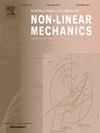Experimental and numerical investigations into tensile and compressive behavior of radial countersunk screw lap joints
IF 3.2
3区 工程技术
Q2 MECHANICS
International Journal of Non-Linear Mechanics
Pub Date : 2025-05-16
DOI:10.1016/j.ijnonlinmec.2025.105159
引用次数: 0
Abstract
Radial countersunk screw lap joints are widely employed in aerospace vehicles to connect various cabin sections. These joints experience complex flight loads, leading to nonlinear deformation and strain behaviors due to the contact and friction mechanisms at the joint interfaces. To gain a deeper understanding of the nonlinear mechanical behavior of such joints, this study conducts static tension and compression tests, complemented by nonlinear finite element simulations. Initially, typical radial countersunk screw lap joint specimens are fabricated and tested under tension and compression loads using an MTS universal testing machine. A preliminary analysis of the load-deformation relationship is performed based on the experimental data. Subsequently, a numerical model is developed using the nonlinear finite element method. This model is validated against experimental results and utilized to predict the evolution of contact behavior and the distribution of stress/strain within the specimens. Furthermore, a parametric analysis is conducted to investigate the influence of key design parameters on the joint's mechanical behavior. The findings indicate that the nonlinear mechanical behavior primarily stems from changes in the contact state between different components, while the differences in tensile and compressive behaviors are driven by variations in contact stiffness. Additionally, the size of the screw-hole clearance and assembly clearance significantly impacts the slip behavior observed in the load-displacement curves. Variations in screw preload and lap length have an important effect on the initial stiffness of the joint. These insights provide a foundation for optimizing the design and performance of radial countersunk screw lap joints for aerospace applications.
径向埋头螺钉搭接接头抗拉抗压性能的实验与数值研究
径向沉头螺钉搭接接头广泛应用于航空航天飞行器中,用于连接各舱段。由于节理界面处的接触和摩擦机制,这些节理承受复杂的飞行载荷,导致非线性变形和应变行为。为了更深入地了解此类节点的非线性力学行为,本研究进行了静态拉伸和压缩试验,并辅以非线性有限元模拟。首先,在MTS万能试验机上制作了典型的径向沉头螺钉搭接试件并进行了拉伸和压缩载荷试验。根据试验数据,对荷载-变形关系进行了初步分析。随后,采用非线性有限元法建立了数值模型。该模型与实验结果进行了对比验证,并用于预测试件接触行为的演变和应力/应变的分布。此外,还对关键设计参数对接头力学性能的影响进行了参数化分析。研究结果表明:试件的非线性力学行为主要源于接触状态的变化,而拉伸和压缩行为的差异主要由接触刚度的变化驱动。此外,螺孔间隙和总成间隙的大小对载荷-位移曲线中观察到的滑移行为有显著影响。螺杆预紧力和搭接长度的变化对接头的初始刚度有重要影响。这些见解为优化用于航空航天应用的径向沉头螺钉搭接接头的设计和性能提供了基础。
本文章由计算机程序翻译,如有差异,请以英文原文为准。
求助全文
约1分钟内获得全文
求助全文
来源期刊
CiteScore
5.50
自引率
9.40%
发文量
192
审稿时长
67 days
期刊介绍:
The International Journal of Non-Linear Mechanics provides a specific medium for dissemination of high-quality research results in the various areas of theoretical, applied, and experimental mechanics of solids, fluids, structures, and systems where the phenomena are inherently non-linear.
The journal brings together original results in non-linear problems in elasticity, plasticity, dynamics, vibrations, wave-propagation, rheology, fluid-structure interaction systems, stability, biomechanics, micro- and nano-structures, materials, metamaterials, and in other diverse areas.
Papers may be analytical, computational or experimental in nature. Treatments of non-linear differential equations wherein solutions and properties of solutions are emphasized but physical aspects are not adequately relevant, will not be considered for possible publication. Both deterministic and stochastic approaches are fostered. Contributions pertaining to both established and emerging fields are encouraged.

 求助内容:
求助内容: 应助结果提醒方式:
应助结果提醒方式:


